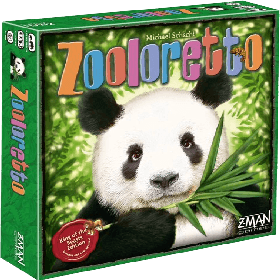Zooloretto
 In Zooloretto gebruikt elke speler kleine, grote, wilde en exotische dieren en hun jongen om zoveel mogelijk bezoekers naar hun dierentuin te lokken - maar wees voorzichtig! De dierentuin moet zorgvuldig worden gepland, want voordat je het weet, heb je misschien te veel dieren en geen ruimte meer voor ze. Dat levert minpunten op! Gelukkig kan je dierentuin uitbreiden. Een dierentuin van een familiespel waarin minder soms meer is...
In Zooloretto gebruikt elke speler kleine, grote, wilde en exotische dieren en hun jongen om zoveel mogelijk bezoekers naar hun dierentuin te lokken - maar wees voorzichtig! De dierentuin moet zorgvuldig worden gepland, want voordat je het weet, heb je misschien te veel dieren en geen ruimte meer voor ze. Dat levert minpunten op! Gelukkig kan je dierentuin uitbreiden. Een dierentuin van een familiespel waarin minder soms meer is...
Aantal spelers: 2 - 5
Spelduur: 27 mn
Complexiteit: 2 / 5
Speel Zooloretto en 1194 andere spellen online.
Geen download nodig - speel rechtstreeks in je webbrowser.
Met je vrienden en duizenden spelers van over de hele wereld.
Gratis.

Speel Zooloretto en 1194 andere spellen online.
Geen download nodig - speel rechtstreeks in je webbrowser.
Met je vrienden en duizenden spelers van over de hele wereld.
Gratis.

Samenvatting van de regels
Overview
The game lasts several rounds. On a player’s turn, they must perform one of the following three actions:
1) Draw a new tile and add it to a delivery truck
2) Take a delivery truck and pass for the rest of the round
3) Carry out one money action
Once each player has taken a delivery truck, the round is over and a new round begins.
The game ends when a player draws and reveals the first tile from the stack covered by the purple wooden disc. The round is played through to the end. Points are scored based on the number of animals and stalls. The player with the most points wins.
Turn Actions
Draw a new tile and add it to a delivery truck
The player draws and reveals the topmost tile from the stack and places it in an open space on a delivery truck of their choice. Their turn is then over.
Each delivery truck has room for up to three tiles. Should all delivery trucks already have 3 tiles on them, then the player cannot choose this action.
Take a delivery truck and pass for the rest of the round
The player chooses a delivery truck and places it, along with any tiles on it, in their play area. They must immediately add the tiles from the truck to their zoo. A player may only choose a delivery truck on which there is at least one tile.
Once a player has taken a truck, they pass for the rest of the round and will not get another turn until the next round.
When the player adds the tiles to their zoo, they must follow the following placement rules:
Animal Tiles: An animal tile may be placed either on an empty enclosure space or in the barn. Each enclosure may contain a maximum of one type of animal tile. However, a player may have multiple enclosures containing the same animal type. If there aren’t any legal spaces for an animal tile left in the enclosures, then the player must place the animal in their barn instead.
Vending Stalls: A vending stall may be placed on an empty stall space or in the barn. If there aren’t any stall spaces left, then the player must place the tile in their barn instead.
Coin Tiles: A coin tile is added to any other coins the player has.
Players may have as many tiles and as many types of tiles (including both animals and vending stalls) as they wish in their barns.
Note: a player may choose to place an animal tile in their barn, even if they have an appropriate empty space in one of their enclosures.
Carry out one money action
The player may carry out one of the following money actions, provided that they can pay for it.
1) Remodel (Move or Exchange)
2) Purchase or Discard a tile
3) Expand the zoo
The placement rules described above must be followed when carrying out these actions. A player may never carry out more than one money action per turn.
Remodel: (1 coin) A player may only remodel their own zoo. There are two remodeling options: Move or Exchange.
Move: The player moves a single animal tile from their barn to an eligible enclosure space in their zoo, or they move any one vending stall tile from its current location to any eligible space in their zoo.
Exchange: The player takes all tiles of one animal type in either their barn or one of their zoo’s enclosures and exchanges them with all tiles of one other animal type in another of their zoo’s locations. An exchange must always involve exactly two areas and the animal types must be different. An exchange involving two areas with the same animal type is not allowed. Exchanging vending stalls is not permitted.
Purchase or Discard a tile: (2 coins) The player may either purchase an animal or vending stall tile from an opponent’s barn or discard an animal or vending stall tile from their own barn.
- Purchase: The player takes the animal or vending stall tile of their choice from the barn of another player and adds it to their own zoo. The other player may not refuse the purchase. 1 coin goes to the other player, 1 coin goes to the bank.
- Discard: The player discards a single animal or vending stall tile of their choice from their barn. The tile is removed from the game.
Expand their zoo: (3 coins) The player pays three coins to the bank and turns their expansion board face up. This expands their zoo by one enclosure and one stall space.
End of a Round
Once each player has taken a delivery truck, the round is over.
The players return the empty trucks to the middle of the table and the next round begins, starting with the player who took the last delivery truck in the previous round.
Additional Rules
Offspring
There are two fertile males and two fertile females of each animal type, distinguishable by the small (M) & (F) symbols on their tiles. When a player adds the partner for a fertile male or female to an enclosure where the partner waits, the two immediately produce an offspring. The player places the offspring tile onto an empty space in the same enclosure.
Once placed, the offspring tile is treated like any other animal tile. If there isn’t any space left in the enclosure, the player must place the offspring in their barn instead.
Notes: All that is required is for the male and female to be in the same enclosure – they do not need to be next to each other. Each male and female can produce an offspring only once. So, for example, no offspring is produced when a third fertile animal is added to an enclosure that already has a fertile pair. Another offspring would only be produced when another partner, creating a second fertile pair, is added to the enclosure. Pairs only produce offspring in enclosures, not in barns or on delivery trucks.
Last enclosure space filled
Some enclosures provide a bonus (in coins) whenever a player places a tile on the last empty space of the enclosure. They receive bonus coins from the bank equal to the number shown in the enclosure (if any are shown).
Exceptions: No bonus is awarded when all enclosure spaces are filled as a result of an Exchange money action. There is also no bonus awarded if an offspring produced by an Exchange action fills the last space.
Game End
The end of the game is triggered when a player draws and reveals the first tile from the stack covered by the purple wooden disc. The round is played through to the end. Once each player has taken a delivery truck, the game is over and scoring takes place.
Scoring
For the animals in an enclosure, the player scores points as follows:
1) For a full enclosure (all spaces filled with animals), the player earns the higher of the two point values shown in the enclosure.
2) For an enclosure with exactly 1 empty space (all but 1 space filled with animals), the player earns the lower of the two point values shown in the enclosure.
3) For an enclosure with two or more empty spaces, the player only scores points if they have a vending stall on at least one of the stall spaces associated with the enclosure. In this case, the player scores 1 point for each animal in the enclosure. If a player has an enclosure with two or more empty spaces and no vending stall in the stall spaces that are associated with the enclosure, they score no points for the enclosure. (Note: When both stall spaces next to a 4-space enclosure are occupied, a player still scores only 1 point per tile.)
For each vending stall type on stall spaces, the player receives 2 points.
For each vending stall type in their barn, the player receives minus 2 points.
For each animal type in their barn, the player receives minus 2 points.
For example: Claus has 3 elephants in their barn and receives minus 2 points for them.
The player with the most points wins. In the event of a tie, the tied player with the most coins wins.

